Q. Which of these has highest constituent of prostaglandins?
a. Synovial sarcoma
b. Subungual glomus tumor
c. Malignant Fibrous histiocytoma
d. Osteoid osteoma
e. Bone infarcts
Answer -
d
Osteoid forming benign bone tumor osteoid osteoma has small foci and radiologically presents as small nidus with reactive sclerosis around.
Thin slice CT or bone scan may be additional imaging modalities.
Night pain with dramatic relief on taking NSAIDS is characteristic feature and is due to high prostaglandins present in the lesion especially PGE2 and PGI2.
a. Synovial sarcoma
b. Subungual glomus tumor
c. Malignant Fibrous histiocytoma
d. Osteoid osteoma
e. Bone infarcts
Answer -
d
Osteoid forming benign bone tumor osteoid osteoma has small foci and radiologically presents as small nidus with reactive sclerosis around.
Thin slice CT or bone scan may be additional imaging modalities.
Night pain with dramatic relief on taking NSAIDS is characteristic feature and is due to high prostaglandins present in the lesion especially PGE2 and PGI2.



